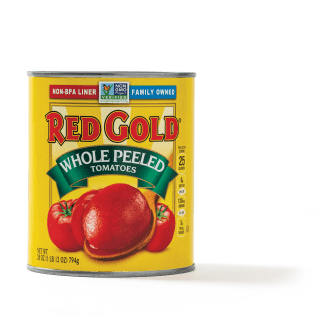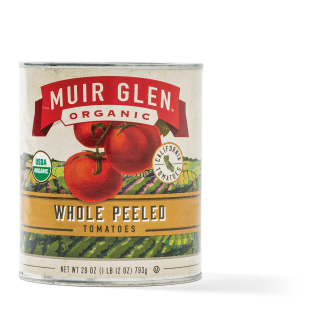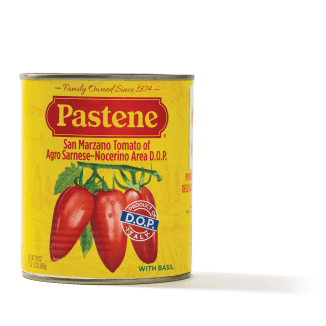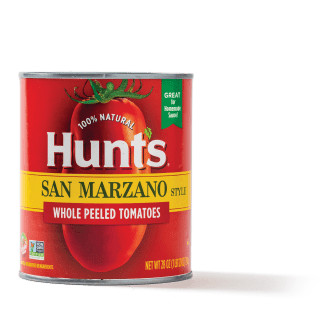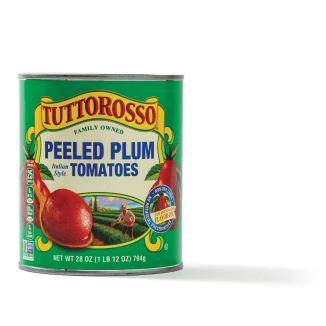Keep a few cans of tomatoes in your pantry, and you’re always ready to cook. Sweet-tart, plump, and juicy, they’re the basis for any number of soups, stews, and sauces. The most versatile canned tomatoes are whole: You can chop, crush, or puree them to your desired size and texture, by hand or in the food processor—we sometimes stick a pair of kitchen shears right into the can to save steps and avoid mess. When you cook them, the best ones have a softer, saucier texture than you can get with many prediced tomatoes.

Traditional American brands such as Hunt’s and Muir Glen have long been sold beside the imported Italian San Marzano canned tomatoes that are prized by chefs. San Marzano refers to both a region in Italy and a variety of plum tomato that is grown there. But recently we’ve spotted a new trend: “San Marzano–style” tomatoes. One of the first was the Pennsylvania-based San Merican Brand, with its familiar white cans printed with thin red tomatoes, which has been growing and processing San Marzano tomatoes in the United States for several years. Other traditional American tomato brands, including Hunt’s, Red Gold, and Muir Glen, followed that company’s lead and have added “San Marzano–style” or “Italian-style” whole peeled tomatoes to their rosters. At about $3.50 to $4.25 per can, they’re more expensive than regular canned tomatoes but still a dollar or two less than imported San Marzano canned tomatoes. We consulted retail data from Circana, a Chicago-based market research firm, and bought top-selling products in each category, including regular whole canned tomatoes, San Marzano, and San Marzano–style, to explore their differences.
What’s Special About San Marzano Tomatoes?
This skinny, elongated variety of plum tomato grown in the area of Agro Sarnese-Nocerino (which includes the town of San Marzano sul Sarno) in the region of Campania was imported from Peru to Italy in about 1770. Sauce made from this tomato is a key ingredient in classic Neapolitan pizza.
It’s prized for its bright red color; dense flesh; thin, easily peeled skin; and fresh, intense taste and aroma. It tends to have smaller seed cavities and lower acidity than most of the plum tomatoes that have traditionally been grown in the United States. To qualify as official San Marzano tomatoes, the specific variety must be grown in that Italian region, a protected designation of origin (Denominazione d’Origine Protetta, or DOP) by the European Union, and confirmed by an overseeing consortium. The rich volcanic soil and scant summer rainfall help these tomatoes develop concentrated flavor. They ripen gradually over a few months, so they must be harvested by hand rather than by machine. (Most commercial tomatoes are machine-picked.)
Canned tomatoes bearing the DOP seal contain only tomatoes and juice of San Marzano tomatoes, a pinch of salt, and occasionally a basil leaf. They do not contain any of the additives, such as calcium chloride (for firmness) and citric acid (to brighten flavor and adjust acidity), that are commonly found in American products. They tend to be more expensive than American brands, costing upwards of $6.00 per 28-ounce can.
How Do the Styles Differ?
After assembling our lineup, we opened cans and examined the contents. All contained plum-shaped tomatoes. It’s important to note that “San Marzano” is the name of a tomato variety and a town in the region where it’s grown, and most plum tomatoes, including Roma (the most popular variety of canned tomatoes in America), were bred from the San Marzano tomato. That said, fresh from the can, the tomatoes looked different from brand to brand: Imported San Marzano tomatoes were distinctly longer and skinnier, and they were softer, just as prescribed by the Italian consortium that regulates them. (See “What’s So Special About San Marzano Tomatoes?”) By contrast, traditional American brands of canned tomatoes (which are typically proprietary varieties of Roma developed for each brand) were clearly firmer, rounder, and plumper than imported San Marzano tomatoes. And the newer San Marzano–style tomatoes sold by American companies? They looked plump and firm, like typical American Roma plum tomatoes.

“Romas are the only ones good for canning,” said Colt Reichart, senior director of marketing and consumer relations at Red Gold in Indiana, the largest privately owned tomato processing company in the country. “They’re thick-walled and able to stand up to the harvesting process, bringing them in, getting them to the factory, and canning them.” (Their oval shape also fits in a can more easily than rounder varieties, he pointed out.)


American brands of “San Marzano-style” or “Italian-style” tomatoes typically don’t resemble genuine imported San Marzano tomatoes. At left, imported San Marzano tomatoes are longer and thinner than “Italian-style” tomatoes from Tuttorosso, an American brand, right.
We measured the interior wall thickness of all the tomatoes in our lineup, averaging three sets of measurements for each brand. The inner walls of American and San Marzano–style plum tomatoes were mostly thicker than those of the imported San Marzano tomatoes, and the specimens had bigger interior chambers that contained more jelly and seeds.
New Tomato on the Block: American “San Marzano–Style” Tomatoes
How close were the San Marzano–style tomatoes to the imports? Honestly, not very. Like all the traditional American brands, all the San Marzano–style tomatoes (except for Hunt’s) contained calcium chloride, a firming agent, and all of them contained citric acid to increase their bright-tart flavor and enhance the perception of sweetness. All contained more sodium than the imported San Marzanos.

It was evident that no brands approached “San Marzano–style” exactly the same way. San Merican reportedly grows San Marzano tomato seeds in the United States. (we could not confirm the variety). But then, the label shows that it treats the tomatoes with calcium chloride, making them firmer than their namesake grown in Italy, and also ladles on the sodium, rendering them uncharacteristically salty (they had the highest sodium per serving of our lineup). For Red Gold, Reichart said, “We grow varieties that are similar to San Marzano varieties and we process them differently, so they are softer.” Did that mean they skipped the calcium chloride? No. Also, the tomatoes still looked plump and roundish, like typical American plum tomatoes, and the label listed citric acid, which is not found in imported San Marzanos. Muir Glen’s San Marzano–style tomatoes had the same sodium level as the company’s regular tomatoes, and the cans’ labels also listed calcium chloride and citric acid. Our tasters slightly preferred the flavor and texture of Muir Glen’s San Marzano–style tomatoes to its regular style; the same went for the pair of Hunt’s products, but the scores were not dramatically different. All were less expensive than genuine imported San Marzano tomatoes.
Raw versus Cooked
When we tasted the tomatoes plain, roughly chopped with some of the can juices in each sample cup, the imported San Marzano tomatoes did not perform well. Like most American consumers, our tasters are accustomed to traditional American products and deemed the imports “mushy” and “bland.” Tasters preferred the “fresh” taste and “firm” texture of the American brands, both regular and San Marzano–style. This was likely due to the imported tomatoes’ lack of firming calcium chloride and very low sodium that left them underseasoned. Tasters also sometimes noted a “metallic” taste to the imports; our science editor noted that salt can help mask metallic flavor in canned tomatoes.

For a second tasting, we used each to make our Simple Tomato Sauce. We’d carefully weighed equal amounts of table salt and fresh minced garlic for each sample, and simmered them for the same amount of time, so the only difference was in the choice of tomatoes. With so few added ingredients and fairly brief cooking, this sauce relies on the quality of the canned tomatoes for its flavor and texture.
Here, the results reversed dramatically: Our tasters appreciated the way genuine San Marzano tomatoes broke down into rich, silky, substantial tomato sauce, with excellent, deep tomato flavor. Any metallic notes completely disappeared. In sauce, the American brands’ tomato flavor was not as highly praised, striking tasters as more of a “blank canvas” for additional flavors to be added by the cook.


We made Simple Tomato sauce with each brand of tomatoes and tasted them to compare their flavor and texture. We assigned random sample numbers, removed all evidence of which brand was which, and each taster sampled in a unique order to prevent palate fatigue.
We don’t typically eat canned whole tomatoes uncooked. As a result, we ranked products by how they performed cooked in sauce. While genuine San Marzano tomatoes were extraordinary in sauce, all the products we tasted are recommended and might find a place in your pantry depending on how you use them and your personal taste and budget.
The Best Whole Canned Tomatoes: Cento San Marzano Certified Peeled Tomatoes
We’ll reach for Cento San Marzano Certified Peeled Tomatoes whenever we’re cooking with whole canned tomatoes. They earned our highest recommendation for their velvety texture and intense, complex tomato flavor. At about $0.16 per ounce, these imports were among the more expensive tomatoes we tried.
Our Best Buy, at about $0.09 per ounce, is a traditional American brand: Red Gold Whole Peeled Tomatoes. Plump, juicy, and emerging intact from the can, they were “fresh tasting” and an excellent “blank canvas” for recipes. Because they’re treated with the firming agent calcium chloride, these are a good choice for uncooked applications or when you want to maintain a chunkier texture in a dish, similar to diced tomatoes. They’d also be a fine choice for recipes such as chili with a lot of other strong flavors.
- Buy 9 top-sellers from data compiled by Circana, a Chicago market research firm
- Taste plain, chopped roughly, with can juices
- Taste in Simple Tomato Sauce, where some juice from the can is added back to the drained tomatoes
- Nutritional information taken from product packaging. We measured the thickness of the inner walls (called the pericarp) of three standard tomatoes per can and averaged the results
- Tasting samples were randomized and assigned three-digit codes to prevent bias; products are listed below in order of preference
- Nutritional information was standardized for a ½-cup (120-gram) serving size
- No calcium chloride for firming, so tomatoes break down naturally when cooked
- Low to moderate sodium
- Balanced tartness and sweetness


